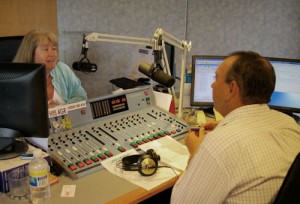
Microphobia…
…. is really the fear of microscopic things, but let’s pretend it’s also fear of the microphone.
The second part of these media blogs deals with interviews for broadcast, and the simple mistakes that even a super-celebrity can make…
There are two types of broadcast stories – the first is the short ‘news’ style segment and the second is the longer feature style of segment. Both of these may be either live or pre-recorded. If it’s an item for a local news show, it’s likely to run maybe a minute. As a feature or discussion, it could be much longer.
Before you do the interview, ask what style of piece they are looking for – that will give you a clue as to how long your answers should be.
In a news style story, your soundbite – the part of the interview that is used – is likely to be between 5 and ten seconds long – that’s 15-30 words. It’s not a lot, so you need to be sure you get your message across.
Anticipate the questions you are going to be asked and know how you want to answer them. Don’t rehearse too much, that will sound fake, but have answers to questions – both good and bad – ready to go.
One word answers are no good – but long, rambling sentences are not good either. Remember that someone is listening to you. Unlike a reading newspaper or magazine, they can’t go back and read it again to be certain they understand. Radio is worse than television – because the listener cannot see your face or body language to help them understand what you mean. You need to speak clearly.
In all cases – watch the interviewer. You are having a conversation with your audience – and the interviewer is their representative. You’ll see them react to what you are saying. If they look like they are trying to interrupt, finish your sentence and then let them speak. The interruption is usually because you are going too long or saying stuff they won’t use. The interruption is their way of bringing you back on topic and getting some focus back.
We are not crooked politicians – the interview process should not be adversarial. For the most part, the interviewer wants you to do a good interview – let them help you.
Here are a couple of technical points…
They will do some sort of sound check before the interview. Do NOT go…. “Testing. One. Two. Three”. That’s not your normal speaking voice. It gives a false reading and the sound guy doesn’t get much time to twiddle his knobs. Speak a long sentence or two. Say something about how pleased you are to be on the show, or the trouble you had getting to the studio. By the time you’ve done that, you will be speaking in your normal voice. You will also have set a normal tone for the conversation that follows.
Do not grab hold of the microphone.
Do not lean in to the mic when the interview starts for real – stay roughly where you were when you gave the sound check.
And here’s one Jennifer Lopez needs to remember. I was watching her give an interview a couple of weeks ago. She was wearing some large and spectacular rings – but every time she put her hand on the desk in front of her, it made a loud Click. The warning – don’t wear bracelets, or necklaces or any jewellery that will rattle or bang or otherwise make a noise when the mic is on.
And finally – one important thing to remember – every mic is ALWAYS live –as some politicians have found to their cost. Never say anything anywhere near a mic that you would not want broadcast…
Come back next week where I’ll be talking about TV – and how to cope with that extra 10 pounds the camera is rumoured to give us…
